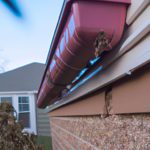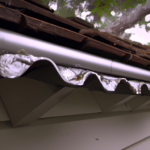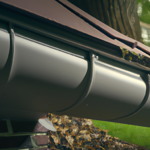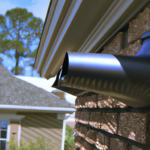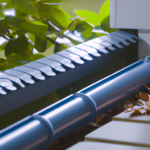-
Table of Contents
“Say goodbye to gutter woes with our guide to fixing common problems.”
Introduction
Common gutter problems can cause serious damage to your home if left unaddressed. Leaks, clogs, and sagging are among the most common issues that homeowners face with their gutters. Fortunately, many of these problems can be fixed with some basic tools and a little know-how. In this article, we’ll take a closer look at these common gutter problems and provide some tips on how to fix them.
Leaking Gutters: Causes and Solutions
Gutters are an essential part of any home’s exterior, as they help to direct rainwater away from the foundation and prevent water damage. However, like any other part of your home, gutters can develop problems over time. One of the most common issues that homeowners face with their gutters is leaking. In this article, we’ll take a closer look at the causes of leaking gutters and how to fix them.
Causes of Leaking Gutters
There are several reasons why your gutters may be leaking. One of the most common causes is damage to the gutter itself. Over time, gutters can become dented or cracked, which can lead to leaks. Additionally, if your gutters are not properly installed, they may not be able to handle the amount of water that flows through them, which can cause leaks.
Another common cause of leaking gutters is clogs. When debris such as leaves, twigs, and dirt accumulate in your gutters, they can create a blockage that prevents water from flowing through. This can cause water to overflow from the gutters and leak into your home.
Solutions for Leaking Gutters
If you have leaking gutters, there are several solutions that you can try. The first step is to inspect your gutters for damage. If you notice any cracks or dents, you may need to replace the damaged section of the gutter. This can be done by removing the damaged section and replacing it with a new one.
If your gutters are not properly installed, you may need to have them reinstalled by a professional. This will ensure that they are able to handle the amount of water that flows through them and prevent leaks.
If your gutters are clogged, you can try cleaning them out yourself. This can be done by using a ladder to access your gutters and removing any debris that you find. You can also use a hose to flush out any remaining debris. If you are not comfortable cleaning your gutters yourself, you can hire a professional to do it for you.
Preventing Leaking Gutters
The best way to prevent leaking gutters is to maintain them properly. This means cleaning them out regularly to prevent clogs and inspecting them for damage. You should also make sure that your gutters are properly installed and that they are able to handle the amount of water that flows through them.
Another way to prevent leaking gutters is to install gutter guards. These are devices that are designed to prevent debris from entering your gutters, which can help to prevent clogs and leaks.
In conclusion, leaking gutters can be a frustrating problem for homeowners. However, by identifying the causes of leaking gutters and taking steps to fix them, you can prevent water damage to your home and keep your gutters functioning properly. Remember to maintain your gutters regularly and to seek professional help if you are not comfortable doing it yourself. With a little bit of effort, you can keep your gutters in good condition and protect your home from water damage.
Clogged Gutters: Prevention and Clearing Techniques
Gutters are an essential part of any home’s exterior, as they help to direct rainwater away from the foundation and prevent water damage. However, gutters can become clogged with debris, causing water to overflow and potentially damage your home. In this article, we will discuss common gutter problems, including clogs, and how to prevent and clear them.
Clogged gutters are a common problem that can lead to serious damage if left untreated. Debris such as leaves, twigs, and dirt can accumulate in gutters, preventing water from flowing freely. This can cause water to overflow and damage your home’s foundation, roof, and siding. To prevent clogs, it is important to clean your gutters regularly.
One way to prevent clogs is to install gutter guards. Gutter guards are screens or covers that fit over your gutters, preventing debris from entering. They are available in a variety of materials, including plastic, aluminum, and stainless steel. While gutter guards can be expensive, they can save you time and money in the long run by reducing the need for frequent gutter cleaning.
If your gutters are already clogged, there are several techniques you can use to clear them. The first step is to remove any large debris by hand. Wear gloves and use a trowel or scoop to remove leaves, twigs, and other debris. Once the large debris has been removed, you can use a garden hose to flush out the remaining debris. Start at the end of the gutter farthest from the downspout and work your way towards it. This will help to ensure that any debris is flushed out of the gutter and down the downspout.
If your gutters are severely clogged, you may need to use a plumber’s snake or a pressure washer to clear them. A plumber’s snake is a long, flexible tool that can be inserted into the gutter to break up and remove clogs. A pressure washer can be used to blast away debris and flush out the gutter. However, it is important to use caution when using a pressure washer, as it can damage your gutters if used improperly.
In addition to preventing and clearing clogs, it is important to inspect your gutters regularly for other common problems, such as leaks and sagging. Leaks can occur when gutters become damaged or develop holes. To fix a leak, you will need to patch the damaged area with a sealant or replace the damaged section of gutter.
Sagging gutters can occur when the hangers that hold the gutters in place become loose or damaged. To fix sagging gutters, you will need to replace the damaged hangers or add additional hangers to provide additional support.
In conclusion, clogged gutters are a common problem that can lead to serious damage if left untreated. To prevent clogs, it is important to clean your gutters regularly and consider installing gutter guards. If your gutters are already clogged, there are several techniques you can use to clear them, including hand removal, flushing with a garden hose, using a plumber’s snake, or using a pressure washer. In addition to preventing and clearing clogs, it is important to inspect your gutters regularly for other common problems, such as leaks and sagging. By taking these steps, you can ensure that your gutters are functioning properly and protecting your home from water damage.
Sagging Gutters: Causes and Repair Methods

Sagging gutters are a common problem that many homeowners face. This issue can lead to water damage, foundation problems, and even pest infestations. In this article, we will discuss the causes of sagging gutters and the repair methods that can be used to fix them.
One of the main causes of sagging gutters is improper installation. If the gutters were not installed correctly, they may not be able to support the weight of the water and debris that collects in them. Over time, this can cause the gutters to sag and pull away from the house.
Another cause of sagging gutters is clogged downspouts. When the downspouts become clogged with leaves, twigs, and other debris, the water cannot flow through them properly. This can cause the water to back up and put pressure on the gutters, causing them to sag.
To repair sagging gutters, the first step is to identify the cause of the problem. If the gutters were not installed correctly, they may need to be reinstalled. This can be a difficult and time-consuming process, so it is best to hire a professional to do the job.
If the cause of the sagging gutters is a clogged downspout, the downspout will need to be cleared. This can be done by using a garden hose or a plumbing snake to remove the debris. Once the downspout is clear, the water should be able to flow through it properly, which will relieve the pressure on the gutters.
Another repair method for sagging gutters is to add additional support. This can be done by installing gutter hangers or brackets. These devices are designed to support the weight of the gutters and prevent them from sagging. Gutter hangers and brackets can be purchased at most home improvement stores and are relatively easy to install.
In some cases, the gutters may need to be replaced entirely. If the gutters are old and worn out, they may not be able to support the weight of the water and debris that collects in them. In this case, it is best to hire a professional to install new gutters.
In conclusion, sagging gutters are a common problem that can lead to serious damage if left untreated. The causes of sagging gutters include improper installation and clogged downspouts. To repair sagging gutters, it is important to identify the cause of the problem and use the appropriate repair method. This may include reinstallation, clearing the downspout, adding additional support, or replacing the gutters entirely. By taking care of your gutters and addressing any problems as soon as they arise, you can prevent costly damage to your home and ensure that your gutters function properly for years to come.
Rusty Gutters: How to Remove and Prevent Rust
Gutters are an essential part of any home’s exterior, as they help to direct rainwater away from the foundation and prevent water damage. However, over time, gutters can develop a range of problems that can compromise their effectiveness. One of the most common issues that homeowners face with their gutters is rust. Rusty gutters not only look unsightly, but they can also lead to leaks and other problems. In this article, we’ll take a closer look at how to remove and prevent rust from your gutters.
Identifying Rusty Gutters
The first step in dealing with rusty gutters is to identify the problem. Rust can appear as reddish-brown spots or streaks on the surface of your gutters. You may also notice that your gutters are starting to corrode or flake away in certain areas. If you’re not sure whether your gutters are rusty, you can use a magnet to test them. If the magnet sticks to the surface of your gutters, it’s a sign that they’re made of metal and could be prone to rust.
Removing Rust from Gutters
Once you’ve identified that your gutters are rusty, it’s time to take action. The first step is to clean your gutters thoroughly. You can use a pressure washer or a garden hose to remove any dirt, debris, or loose rust from the surface of your gutters. Be sure to wear gloves and eye protection when cleaning your gutters, as the debris and rust can be sharp and dangerous.
After cleaning your gutters, you’ll need to remove any remaining rust. There are several ways to do this, depending on the severity of the rust. For light rust, you can use a wire brush or sandpaper to scrub away the rust. For heavier rust, you may need to use a rust remover or a chemical cleaner. Be sure to follow the instructions carefully and wear protective gear, as these products can be harsh and toxic.
Preventing Rust in Gutters
Once you’ve removed the rust from your gutters, it’s important to take steps to prevent it from coming back. One of the best ways to prevent rust is to apply a rust inhibitor or a protective coating to your gutters. These products create a barrier between the metal surface of your gutters and the elements, preventing rust from forming.
Another way to prevent rust is to keep your gutters clean and free of debris. When leaves, twigs, and other debris accumulate in your gutters, they can trap moisture and create the perfect environment for rust to form. By cleaning your gutters regularly, you can prevent this from happening and extend the life of your gutters.
Conclusion
Rusty gutters can be a frustrating and unsightly problem for homeowners. However, with the right tools and techniques, it’s possible to remove rust from your gutters and prevent it from coming back. By identifying the problem, cleaning your gutters thoroughly, and taking steps to prevent rust, you can keep your gutters in good condition and protect your home from water damage. If you’re not comfortable tackling this job on your own, consider hiring a professional gutter cleaning and repair service to help you get the job done right.
Improperly Pitched Gutters: How to Adjust for Proper Water Flow
Improperly Pitched Gutters: How to Adjust for Proper Water Flow
One of the most common gutter problems is improper pitch. Gutters that are not pitched correctly can cause water to pool and overflow, leading to damage to your home’s foundation, roof, and siding. Fortunately, adjusting the pitch of your gutters is a relatively simple fix that can be done with a few basic tools.
Before you begin, it’s important to understand what proper pitch means. Gutters should be pitched at a minimum of 1/4 inch per 10 feet of gutter. This ensures that water flows towards the downspouts and away from your home. If your gutters are not pitched correctly, you may notice water pooling in certain areas or overflowing during heavy rain.
To adjust the pitch of your gutters, you will need a ladder, a level, and a few basic tools. Start by cleaning out any debris from your gutters and downspouts. This will ensure that water can flow freely and help you identify any areas that may be clogged or damaged.
Next, use a level to determine the current pitch of your gutters. Place the level on the bottom of the gutter and check to see if it is level or sloping towards the downspout. If it is not sloping towards the downspout, you will need to adjust the pitch.
To adjust the pitch, start at the downspout and work your way towards the end of the gutter. Use a ladder to access the gutter and loosen the hangers that hold the gutter in place. You may need to use a drill or screwdriver to remove the screws or nails that hold the hangers in place.
Once the hangers are loosened, use a level to adjust the pitch of the gutter. Lift the end of the gutter that is farthest from the downspout and adjust it until it is sloping towards the downspout at a rate of 1/4 inch per 10 feet. Use the level to ensure that the gutter is sloping correctly and then tighten the hangers back in place.
Repeat this process for each section of gutter until the entire system is pitched correctly. Once you have adjusted the pitch, run water through the gutters to ensure that water is flowing towards the downspouts and away from your home.
In addition to adjusting the pitch of your gutters, it’s important to ensure that they are properly secured to your home. Loose or damaged hangers can cause gutters to sag or pull away from your home, leading to leaks and other problems. Check your hangers regularly and replace any that are damaged or missing.
By taking the time to adjust the pitch of your gutters and ensure that they are properly secured, you can prevent many common gutter problems and protect your home from water damage. If you are unsure about how to adjust your gutters or notice any signs of damage, it’s always best to consult with a professional gutter installer or repair service. They can help you identify and fix any problems before they cause serious damage to your home.
Q&A
1. What are some common gutter problems?
– Leaks, clogs, sagging, rust, and improper installation are some common gutter problems.
2. How can I fix a leaky gutter?
– Clean the affected area, apply a waterproof sealant, and let it dry completely before testing for leaks.
3. What causes gutters to sag and how can I fix it?
– Sagging gutters are usually caused by loose or damaged hangers. Replace or tighten the hangers to fix the problem.
4. What is the best way to prevent gutter clogs?
– Regular gutter cleaning is the best way to prevent clogs. You can also install gutter guards to keep debris out.
5. Can I fix a rusted gutter or do I need to replace it?
– If the rust is minor, you can sand it off and apply a rust-inhibiting primer and paint. However, if the rust is extensive, it may be best to replace the gutter.
Conclusion
Conclusion: Common gutter problems such as leaks, clogs, and sagging can cause serious damage to your home if left untreated. It is important to identify these issues early and take the necessary steps to fix them. Regular maintenance and cleaning can prevent many of these problems from occurring in the first place. If you are unsure how to fix a gutter problem, it is best to consult a professional to ensure the job is done correctly and safely.
